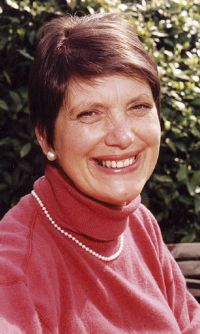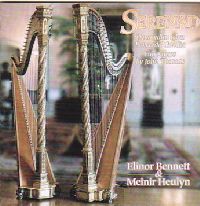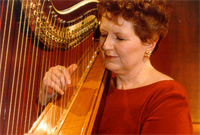| Serenâd by Elinor Bennett and Meinir Heulyn |
Two of Wales’ leading harpists join forces to present, for the first time on CD, harp duos by John Thomas. This is the third album for Elinor and Meinir to record harp duets on the Sain label. Buy this album now CD: £9.99 + p&p |
| Track Listing | |||
| 1 | Serenâd | Schubert arr. John
Thomas |
4.08 |
| Grand Duet | John Thomas | ||
| 2 | Allegro con brio | 6.09 |
|
| 3 | Adagio | 5.08 |
|
| 4 | Allegro con spirito | 3.54 |
|
| 5 | Ave Maria | Schubert arr. John Thomas | 6.34 |
| 6 | Souvenir Du Nord | John Thomas | 8.59 |
| 7 | Sonnambula | Bellini arr. John Thomas | 11.23 |
| 8 | Scenes of Childhood | John Thomas | 10.19 |
| 9 | Le Gassier Valse | Venzano arr. John Thomas | 3.30 |
| 10 | Cambria | John Thomas | 11.03 |
| Sleeve Notes |
Born in Bridgend, Glamorgan, on St David’s Day, March 1st 1826, John Thomas (Pencerdd Gwalia) was very proud of his Welsh ancestry, and of the fact that he was born on St David’s Day. Although, as a typical Victorian, he was loyal, first and foremost to Queen and country, he was also intensely patriotic towards the country of his birth. Throughout his life, his native land, his mother tongue, and the music and musical traditions of Wales were the cornerstones of his existence. Neither should it be forgotten that he left his homeland when he was only fourteen years old, and that for more than 70 years, he lived and worked in London, and that London was the focus of his life. It was as a gifted twelve-year old that John Thomas first drew the attention of the public, when, in October 1838, he was a competitor at the Eisteddfod held by the Cymreigyddion at Abergavenny. It was the triple harp that he played that day, and he played it in the traditional Welsh manner, placing the harp on his left shoulder, and playing the treble with his left hand and the bass with his right hand – the opposite of conventional pedal harp technique. The set piece was the old Welsh tune, Nos Galan, and as winner of the competition, his prize was a brand-new triple harp, specially commissioned from the Cardiff harpmaker, Bassett Jones. Even in the last year of his life, this harp stood proudly in the front parlour of his new house, ‘Llanddulas’, Station Road, New Barnet, just outside London, the brass plaque on its neck being inscribed: ‘No.4. Abergavenny Cymreigyddion / To John Thomas aged eleven (Note the error) for excellence on the harp/ October 1838. Bassett Jones, Harpmaker, Cardiff, no.115’. Ada, Lady Lovelace, heard him play. The only daughter of the poet Byron, she was herself a harpist, and she was so impressed that she offered to pay three-quarters of his £20.00 annual fees at the Royal Academy of Music, on condition that his father undertook to pay the rest. John Thomas’s father was a tailor by trade, and having been assured of an adequate living in the capital by Lady Lovelace and her husband, and wishing to take advantage of all the opportunities opening up for his eldest son, he moved the whole family from Bridgend to live in London. In September 1840 John Thomas entered the Royal Academy of Music, then based at 4 Tenterden Place, Hanover Square. He studied the harp with John Balsir Chatterton, who recalled the early student days in a letter published in the Caernarvon and Denbighshire Herald in November, 1869: “It was the triple harp which Thomas, as a boy, played when he came to the Royal Academy of Music… I need not say what he has done since then, for his reputation as a harpist is well known all over Europe; and I have no hesitation in saying that if he had not forsaken the triple harp for the pedal harp, he would never have accomplished what he has done.” He remained a student for six years. He studied harmony and composition, and improved his command of the English language. He learned to play the pedal harp on the ‘correct’ shoulder, and when he went home he would pass on what he had learnt to his younger brothers, Thomas (b. Bridgend, 1829; d. Ottawa, Canada, 1913) and Llewelyn (b. Bridgend, 1831; d. Melbourne, Australia, 1889). Before leaving the Academy he had become a sub-professor and an ARAM, and during his time there he had composed not only a Harp Concerto, but also three operas, and opera was to become an important part of his life. His first professional contract, which ran from the first week of March until 13 July 1851, was as harpist to the Royal Italian Opera at Her Majesty’s Theatre. He earned 15 shillings per performance - in those days quite a considerable sum - and the theatre attracted world-famous artistes such as Joseph Tagliafico, Antonio Tamburini, Jenny Lind, Josefa Le Gassier, Desirée Artôt, and, in 1861, Adelina Patti. John Thomas was a member of the company when the theatre staged the first London performances of Verdi’s Rigoletto, Il Trovatore and Don Carlos, Meyerbeer’s Les Prophètes, and Benvenuto Cellini by Hector Berlioz. He had bought his first new harp (no. 5939) from the Erard company in 1850, and in September 1851, the opera season being over, he started on the first of his annual continental tours as a solo harpist. It is whilst he is in Vienna on this tour that we hear for the first time of his composing and playing harp duets, with his Viennese patron, Jeanette, Countess Esterházy, as his partner. He continued to compose duos both for two harps and for harp and piano throughout his life, and the arrangement of Schubert’s famous Serenade (Track 1) with which the present CD openscomes from the his very last period of compositional activity, dating from 1900, when he arranged 14 of Schubert’s songs for harp and piano. Ave Maria (Track 5) comes from the same series. Both the Grand Duet (Tracks 2, 3 and 4) and the Souvenir du Nord (Track 6) are dedicated to a Welsh-born patron. ‘Mrs Lucy of Charlecote Park’ was born Mary Elizabeth Williams at Bodelwyddan Castle, St Asaph, and both she and her sister ‘Miggy’ (later to become Lady Willoughby de Broke) were talented harpists. In her book Mistress of Charlecote:The Memoirs of Mary Elizabeth Lucy,she gives a very amusing account of the Abergavenny Eisteddfod which led to her first meeting with John Thomas at Llanover in 1853 and to her subsequent lessons with him at her home. “Mr Thomas kept me to scales and exercises for the first few weeks, and I did learn his way, and before I was very much older, I was able to play many a difficult duet with him. I would get up an hour earlier to have a good practice before breakfast, and I would go to sleep trying to hold my thumb up.” As her harp teacher, ‘Mr Thomas’ became a frequent guest; as an enthusiastic patroness, she attended his concerts over a period of some 35 years. The Grand Duet – his only original composition for two harps – was dedicated to her in 1865, although eleven years previously she had already been the dedicatee of the Souvenir du Nord, a duo based on melodies he had heard on the Russian tour he had undertaken in the autumn of 1853. John Thomas and John Bilson Binfield gave one of the first performances of this work in Paris at the Salle Henri Herz on 30 March,1854. A few weeks earlier that same month, in the same city, no less a critic than Hector Berlioz had enthused about John Thomas in the Journal des Débats, saying “Voilà comment on joue de la harpe…. Il m’a charmé, fasciné, magnetisé.” The soprano Adelina Patti held a special place in the hearts of music-loving Welsh Victorians, and it was, of course, at her Welsh castle, Craig-y-Nos, in the upper reaches of the Tawe Valley that she died, on 27 September 1919. She was only eighteen years old when she made her London début on 14 May 1861, stunning the audience with her brilliant assumption of the role of Amina in Vincenzo Bellini’s romantic opera, La Sonnambula. John Thomas had been in the orchestra pit that night, and like everyone else in the theatre, he had lost his heart to the beautiful young soprano who sang so brilliantly. Seven years later, he composed his delightful duo on themes from La Sonnambula (Track 7), dating it precisely on the day of its completion, 10 November, 1868. Another soprano who sang at Her Majesty’s Theatre whilst John Thomas was a member of the orchestra was the inspiration for his arrangement of Le Gassier Waltz (No. 9). Born in Bilbao in 1821, Josefa Le Gassier enjoyed enormous acclaim in 1855 when she performed the ballata ‘Forest Fairy’ by Luigi Venzano (1814-1878), which came to be known as Le Gassier Waltz. Interestingly, another of Venzano’s waltzes became known as the Artôt Waltz after the soprano Désirée Artôt, to whom John Thomas was briefly engaged in 1861. Her next serious suitor after John Thomas was, it appears, Tchaikovsky, but he too was rejected in favour of a Spanish baritone by the name of Mariano Padilla y Ramos. Amongst John Thomas’s most famous harp duets are three more operatic fantasias based, successively, on themes from Bellini’s Norma (1884), Rossini’s Moses (1884) and Bizet’s Carmen (1885), this last having been composed after hearing Adelina Patti sing Carmen at Covent Garden earlier the same year. But the best-known of all John Thomas’s harp duets – the indubitable ‘classics’ of the genre – are Scenes of Childhood (Track 8) and Cambria (Track 10). It was John Thomas’s former teacher, John Balsir Chatterton (1805-1871) who was his duo partner in Scenes of Childhood when they played together at the first Grand Concert of Welsh Music which was held at St James’ Hall, Piccadilly, on 4 July 1862. There was a choir of 400 voices, and an ensemble of no less than twenty harps, and the concert was so successful that it had to be staged again on the 26 July and the venue moved to the Crystal Palace. The sensational success of these two concerts led to another scheduled for ‘St David’s Evening’, 28 February 1863, for which John Thomas composed a second duo for himself and Chatterton, originally - according to the manuscript which is in the National Library of Wales - giving it the rather insipid title Scenes of Childhood II. This title, however, was crossed out, and replaced by the awe-inspiringly simple, but memorable, rousing, and patriotic alternative, Cambria, a title which has guaranteed its success and its popularity for almost a century and a half. Every available photograph of John Thomas shows him sitting at one of Erard’s elegant ‘Gothic’ model harps, and indeed, during his lifetime he bought five new Erard harps, the last two in 1890 (No. 6680) and 1891 (No. 6537). For this recording it has been possible to bring together two Erard ‘Gothic’ harps, nos. 6758 (1902) and 6761 (1904), thus ensuring the exciting prospect of re-creating the most authentic sound possible. This is the sound which John Thomas heard in his aural imagination as he composed, and this is the sound which he heard when his duos were played. The cover picture with harps nos. 6758 and 6761 was taken at Bodelwyddan Castle, the very house which, 150 years ago, echoed to the sounds of the harp duets of Mrs Lucy, Mistress of Charlecote, and John Thomas, Pencerdd Gwalia. |
Original
Welsh Text © Ann
Griffiths, July 2000 |
Credits Digitally recorded by Sain at Nimbus,
Gwent, during the Spring of 2000 |
| Instruments: | Two Harps |
| Genre: | Traditional Welsh |
| Format: | CD |
| Our Ref: | A0126 |
| MCPS: | SCD2254 |
| Label: | Sain |
| Year: | 2000 |
| Origin: | Wales (UK) |
Elinor Bennett is one of Wales' most distinguished musicians. She enjoys a formidable reputation on the international stage both through live performances and numerous recordings. Her wide repertoire encompasses many styles and periods and her concert programmes demonstrate the versatility of an artist who is equally at home with the music of contemporary composers as she is in the traditional music of her native Wales. Want to know more? ......... |

Meinir Heulyn (Harp) Born in Ceredigion, Meinir Heulyn started playing
the harp at the age of ten. After graduating from University College,
Cardiff she continued her studies at the Genova Conservatorio.
Since 1972 she has held the post of principal harp with the Orchestra
of Welsh National Opera, with whom she has both performed and recorded
extensively. She provided solo accompaniment to both Charlotte
Church and Bryn Terfel on their best-selling albums. Want to know more? ......... |

 Elinor
Bennett (Harp)
Elinor
Bennett (Harp)



